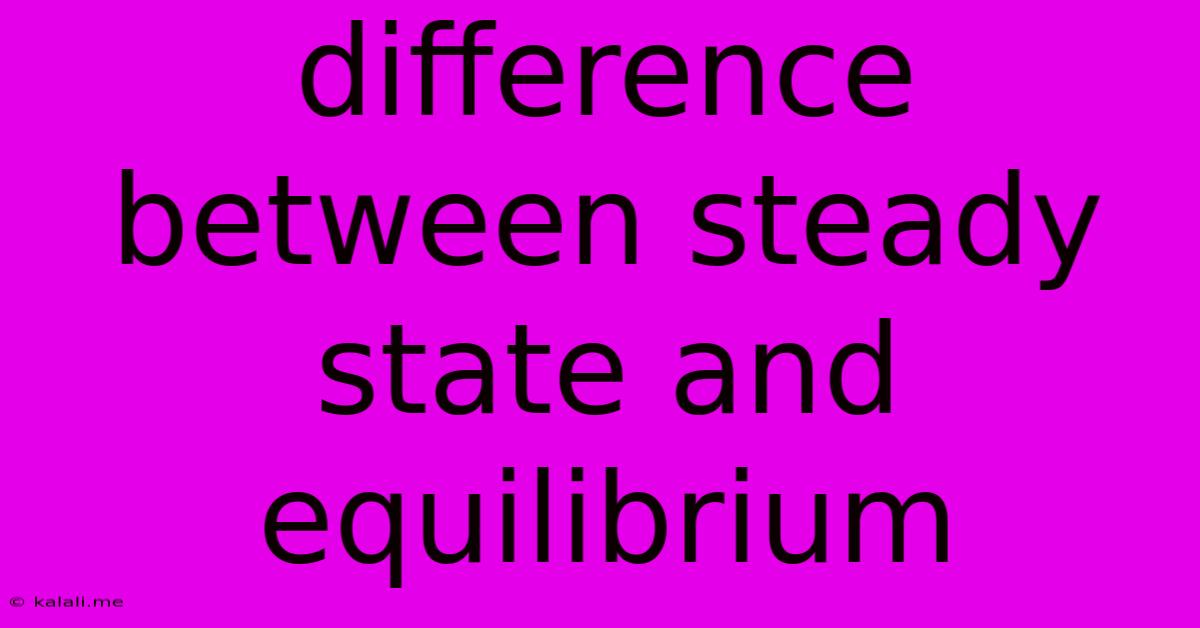Difference Between Steady State And Equilibrium
Kalali
May 29, 2025 · 3 min read

Table of Contents
Steady State vs. Equilibrium: Understanding the Key Differences
Understanding the difference between steady state and equilibrium is crucial in various scientific disciplines, from chemistry and physics to biology and engineering. While both terms describe a system that's not changing over time, they differ significantly in their underlying mechanisms and implications. This article will delve into the core distinctions, providing clear examples to solidify your understanding.
What is Equilibrium?
Equilibrium describes a state where a system is in balance, with no net change occurring. This means that the forward and reverse processes are occurring at the same rate, resulting in no observable macroscopic changes. A crucial characteristic of equilibrium is that it's reversible. If you perturb the system (e.g., by changing temperature or pressure), it will spontaneously adjust to reach a new equilibrium state. It’s a state of maximum stability for a closed system.
Key characteristics of Equilibrium:
- No net change: The rate of the forward reaction equals the rate of the reverse reaction.
- Reversible: The system can be easily perturbed and will readjust to a new equilibrium.
- Minimum free energy: For systems at constant temperature and pressure, equilibrium corresponds to the minimum Gibbs Free Energy.
- Closed system: Usually applies to closed systems, meaning no exchange of matter or energy with the surroundings.
Examples of Equilibrium:
- Chemical Equilibrium: In a reversible chemical reaction, equilibrium is reached when the rate of the forward reaction equals the rate of the reverse reaction, resulting in constant concentrations of reactants and products.
- Phase Equilibrium: The coexistence of ice and water at 0°C and 1 atm pressure is a phase equilibrium.
What is Steady State?
A steady state, on the other hand, is a dynamic condition where the system's properties remain constant over time, despite continuous inflows and outflows of matter and/or energy. Unlike equilibrium, a steady state is not necessarily reversible; disrupting the input or output flow will not result in the system spontaneously returning to its previous state. It represents a balance between opposing processes, but these processes may not be the same.
Key characteristics of Steady State:
- Constant properties: System properties like concentration, temperature, and pressure remain constant over time.
- Continuous flows: There is a continuous flow of matter and/or energy into and out of the system.
- Not necessarily reversible: A perturbation may lead to a new steady state or even a complete disruption of the system.
- Open system: Typically applies to open systems that interact with their surroundings by exchanging matter and energy.
Examples of Steady State:
- River Flow: The water level in a river section may remain constant (steady state) despite the continuous inflow of water from upstream and outflow downstream.
- Biological Systems: The concentration of certain metabolites in a living cell can remain constant (steady state) even though metabolic reactions are constantly occurring, resulting in continuous production and consumption.
- Traffic Flow: The density of cars on a highway might remain constant at a specific point even though cars are constantly entering and exiting.
The Crucial Difference Summarized:
| Feature | Equilibrium | Steady State |
|---|---|---|
| System Type | Closed | Open |
| Net Change | No net change | No net change (but continuous flows) |
| Reversibility | Reversible | Not necessarily reversible |
| Flows | No significant flows | Continuous inflows and outflows |
| Stability | Maximum stability (minimum free energy) | Dynamic stability; perturbation may disrupt |
In essence, equilibrium is a static balance in a closed system, while steady state is a dynamic balance in an open system. While both states show no net change in measurable properties over time, the underlying mechanisms and implications are vastly different. Understanding this distinction is key to interpreting systems across various scientific and engineering domains.
Latest Posts
Latest Posts
-
Feeding As A Vampire In Skyrim
May 30, 2025
-
Three Way Switch Power To Switch
May 30, 2025
-
How To Run Tar Gz File In Linux
May 30, 2025
-
Integration Of X 2 A 2 1 2
May 30, 2025
-
How Do You Measure Offset On A Wheel
May 30, 2025
Related Post
Thank you for visiting our website which covers about Difference Between Steady State And Equilibrium . We hope the information provided has been useful to you. Feel free to contact us if you have any questions or need further assistance. See you next time and don't miss to bookmark.